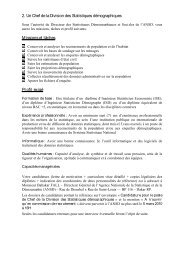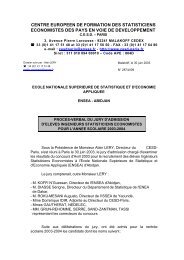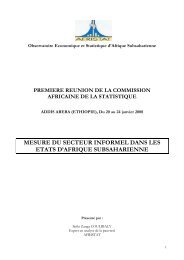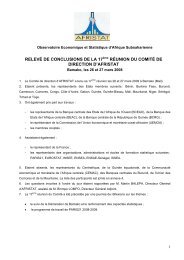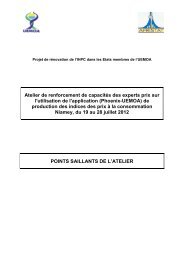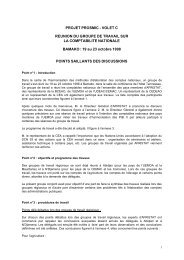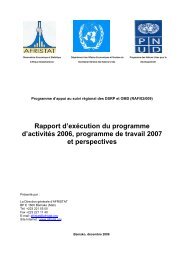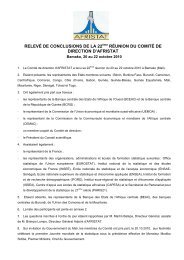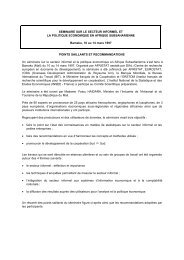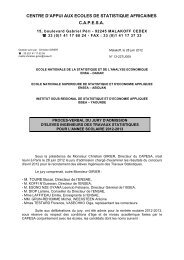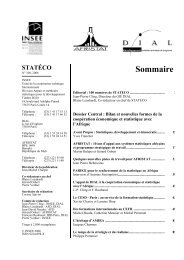Global Purchasing Power Parities and Real Expenditures - Afristat
Global Purchasing Power Parities and Real Expenditures - Afristat
Global Purchasing Power Parities and Real Expenditures - Afristat
You also want an ePaper? Increase the reach of your titles
YUMPU automatically turns print PDFs into web optimized ePapers that Google loves.
Tables of Results 137Individual Individual Collective ChangesRestaurants Miscellaneous consumption consumption consumption Gross fixed Machinery inventories Balance of<strong>and</strong> goods <strong>and</strong> Net purchases expenditure expenditure expenditure capital <strong>and</strong> Other <strong>and</strong> exports <strong>and</strong>Education hotels services from abroad by households by government by government formation equipment Construction products valuables imports16.1 4.9 5.7 -3.5 85.6 5.0 9.5 22.0 4.9 14.6 2.4 -0.2 -21.94.7 0.9 4.5 0.7 35.1 5.5 13.9 18.0 9.3 6.0 2.7 0.1 27.33.9 0.3 1.0 0.0 17.9 4.0 7.4 33.6 16.0 13.6 4.0 1.9 35.16.8 1.4 1.3 1.4 28.6 8.3 11.8 16.5 7.2 7.9 1.5 1.3 33.55.0 1.4 0.4 0.0 69.6 4.6 6.4 23.7 12.1 11.6 0.0 -6.3 2.04.4 1.7 5.5 -0.1 64.2 4.7 7.5 19.0 7.1 11.2 0.7 -0.5 5.16.3 1.5 2.4 0.4 41.7 6.6 11.0 17.9 7.5 9.1 1.3 1.1 21.75.3 4.2 8.6 0.0 59.6 8.8 8.6 21.6 7.6 11.9 2.1 0.7 0.1Individual consumption expenditure by households includes the actual <strong>and</strong> final consumption expenditure incurred by households on individual goods <strong>and</strong> services. It also includes expenditureon individual goods <strong>and</strong> services sold at prices that are not economically significant.Individual consumption expenditure by government includes the actual <strong>and</strong> imputed final consumption expenditure incurred by general government on individual goods <strong>and</strong> services.Collective consumption expenditure by government consists of expenditures incurred by general <strong>and</strong> local governments for collective consumption services such as defense, justice, generaladministration, <strong>and</strong> the protection of the environment.Gross fixed capital formation is measured by the total value of a producer’s acquisitions, less disposals, of fixed assets during the accounting period, plus certain additions to the value of nonproducedassets (such as subsoil assets or major improvements in the quantity, quality, or productivity of l<strong>and</strong>) realized by the productive activity of institutional units.Machinery <strong>and</strong> equipment includes fabricated metal products, general purpose machinery, special purpose machinery, electrical <strong>and</strong> optical equipment, transport equipment, <strong>and</strong> other manufacturedgoods.Construction covers the construction of new structures <strong>and</strong> the renovation of existing structures. Structures include residential buildings, nonresidential buildings, <strong>and</strong> civil engineering works.Other products include products of agriculture, forestry, fisheries, <strong>and</strong> aquaculture, as well as software products.Changes in inventories <strong>and</strong> valuables (including work in progress) consist of changes in (a) stocks of outputs that are still held by the units that produced them before their being further processed,sold, delivered to other units, or used in other ways <strong>and</strong> (b) stocks of products acquired from other units that are intended to be used for intermediate consumption or for resale withoutfurther processing; they are measured by the value of the entries into inventories, less the value of withdrawals <strong>and</strong> the value of any recurrent losses of goods held in inventories. PPPs are notestimated directly; instead, they are imputed using PPPs for consumer goods equipment.Balance of exports <strong>and</strong> imports is the difference in value between the total exports <strong>and</strong> total imports of an economy during a specific period of time.Note:a. Kuwait, Qatar, Saudi Arabia, Yemen, Mauritania, Djibouti, Brunei, Bangladesh, Maldives, Iran, <strong>and</strong> Pakistan do not have expenditures on alcoholic beverages or narcotics.b. Burundi: Submitted prices, but did not provide official national accounts data.c. Egypt, Arab Rep.: Participated in both the Africa <strong>and</strong> Western Asia regions. The results for Egypt from each region were averaged by taking the geometric mean of the PPPs, allowing Egypt tobe shown in each region with the same ranking in the world comparison.d. China: Results for China were based on national average prices extrapolated by the World Bank <strong>and</strong> ADB using price data for 11 cities submitted by the National Bureau of Statistics for China.The data for China do not include Hong Kong, Macao, <strong>and</strong> Taiwan, China.e. Russian Federation: Participated in both the CIS <strong>and</strong> OECD-Eurostat comparisons. The PPPs for Russia are based on the OECD comparison. They were the basis for linking the CIS comparisonto the Eurostat-OECD program.... Data suppressed because of incompleteness.



